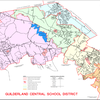Capital fund included in $3.5M library plan
GUILDERLAND — In overseeing his first budget proposal, Timothy Wiles, the new director of the Guilderland Public Library, said, “for any public institution that attempts to grow and thrive, the economic climate is difficult.”
The library’s board unanimously passed a $3.5 million budget proposal for next year, an increase of 1.42 percent over last year’s spending plan.
The public will have its say on May 20, at which time voters will also elect four library trustees out of a field of five: incumbents Robert Feller, who serves as secretary; Barbara Fraterrigo; and Carroll Valachovic, who serves as treasurer, and newcomers Karen Carpenter Palumbo and Carolyn Williams.
The top three vote-getters will serve full five-year terms and the fourth-place candidate will fill out the term left when Robert Ganz resigned from the 11-member board.
“The more candidates you have, the better,” said Wiles, “for the generation of ideas.”
Next Thursday, May 8, a public briefing and comment session on the budget will be held at the library, at 2228 Western Ave., starting at 7 p.m.
The total tax levy for the $3,541,967 plan would be $3,437,467, a 0.18-percent increase over this year. The library estimates that Guilderland residents will pay $1.14 per $1,000 of assessed valuation —two cents more than this year.
The proposed budget stays under the state-set levy limit and so requires a simple majority to pass; if a budget goes over the levy limit, 60 percent of the popular vote is needed to pass it. Last May, the library budget passed with 56 percent of the vote, down from 66 percent the preceding year — a percentage more typical for Guilderland where a library budget vote has never failed.
In June 2012, however, a $13 million expansion project that would have updated the library and nearly doubled its size was defeated, 3 to 1, by about a quarter of Guilderland’s 22,245 registered voters.
Consequently, Wiles said this week that one of the challenges facing the library is “how to keep a 22-year-old building serving the public optimally.” The building needs re-roofing, he said, and some of its 26 heating and cooling pumps are beginning to fail. “They tend to die with no warning,” as one did his first month on the job, Wiles said, and cost an average of $7,000 each to replace.
The biggest news in the proposed budget is that the library board has created a capital reserve fund, at $90,000.
“With the capital reserve fund, we’ll be ready,” said Wiles of taking care of needed repairs. He noted that grant funding that may be available for such projects often requires base funding to leverage. “You have to have money to play in that world,” he said.
“It’s a beautiful, beautiful building,” said Wiles of the library, with a design that “still looks fresh and new.” But, he went on, “It’s beginning to show its age and we have to be proactive.”
A long-range planning committee will reconvene sometime this summer, Wiles said, to “look at the physical facility and look at what the library should do in 10 or 15 years.”
He also said the board is viewing the bond defeat as “a blank slate, waiting to reach out and see what the public wants.”
Wiles estimates that circulation and foot traffic are both down about 10 percent from the high points at the depth of the Great Recession. Like his predecessor, Barbara Nichols Randall, he believes that library use increases in times of economic depression.
Total circulation for the fiscal year 2012-13 was 498,188, Wiles reported. The previous year, circulation was about 590,000, and the year before that, it was about 640,000.
Wiles said that roughly 3 percent of the library’s circulation is electronic. For 2012-13, he reported, 16,634 electronic materials were circulation. On his listening tour around town, Wiles said, he has found many people are surprised to learn they can download e-books and audio books from the library.
Using the 36,131 population figure for Guilderland from the 2010 census, Wiles calculated that about 14 items circulate annually for each resident. “I think this is a fantastic number,” he said, adding that every item in the library’s collection circulates an average of 2.47 times per year.
While he waited recently in a store’s checkout line, Wiles said, he was “astonished” to see DVDs selling for $24.99. “I can borrow it for free,” he said. “It doesn’t make any economic sense to buy it. Let’s think of the public library first. Libraries purchase things jointly for communities that people can’t or won’t purchase. As director, I want to get people back into the habit.”
The Guilderland library’s annual attendance for the last fiscal year was 225,889, which, Wiles calculates, means the average Guilderland resident enters the library 6.25 times a year; 19,695 hold library cards. The library had about 288,000 visits the previous year, and roughly 326,000 visits the year before that.
“We’re not in the book business,” said Wiles, borrowing a line from a St. Paul library video. “We’re in the Guilderland business.”
And what is the Guilderland business?
“Whatever people in Guilderland want it to be,” said Wiles. Programs can be developed on anything from health to money management, he said.
Last year, the library offered 702 programs, Wiles said, attended by an average of 69 people. Roughly half of those programs were for kids, he said.
On his listening tour, Wiles said, he is paying attention to suggestions. For example, he said, Guilderland Councilman Brian Forte asked about Red Cross babysitting courses the library used to host. “Now, we’re planning on doing that in the fall,” Wiles said.
Revenues
The lion’s share of budget revenues for Guilderland, and public libraries across the state, come from property taxes.
The other sources for Guilderland next year total just $104,500, down from $117,000 this year.
State money is estimated at $8,000, the same as this year.
Fines and fees are expected to bring in $46,000, down $9,000 for this year. Wiles surmises this is because more patrons are receptive to e-mails letting them know they have books that are due. Also, the growth in using electronic books reduces the overdue fees.
“You don’t have to physically return them,” said Wiles. “They just disappear from the reader.”
Interest is expected to decline from $5,000 to $1,000; copier fees are to hold steady at $8,000; and gifts and grants are expected to increase from $15,000 to $19,000.
The Book Nook, which sells donated items, is expected to bring in $17,000, which is $3,000 less than this year. And, finally, non-resident fees are slated at $5,500, down $500 from this year.
“You have to be a devoted library person to join a system outside your service area,” said Wiles of the $50 fee.
He also said, “Many people don’t know almost any library in New York State participates in inter-library loan.”
Some people, Wiles said, don’t realize that taxes pay for a public library. “Still, people are welcome to come to our programs or to use our computers...It’s just checking out that the fee buys you.”
The Guilderland Public Library follows the school district’s boundaries, which include most of Guilderland and parts of Bethlehem, New Scotland, and Knox. The estimated tax rates on the proposed $3.5 million budget, which takes into account the state-set equalization rate, for each of those towns is: $1.14 for Guilderland, $1.05 for Bethlehem, $1.05 for New Scotland, and $1.66 for Knox, which hasn’t recently had a town-wide property revaluation.
Expenditures
As is typical of library budgets, Guilderland’s largest expenditure is for salaries and benefits. About $57,000 less is budgeted for next year — $2,568,137. The reduction is largely because of retirements, and new staffers being hired at lower salaries, said Wiles.
The library employs 57 people, he said, many of them part-time, for 43 full-time equivalents.
Wiles lauded the expertise of the librarians. In an era when many people think they can simply do their own research online, he said at the library they can “talk to a true information expert.”
Wiles gave an example of someone who was diagnosed with a fatal neurological condition so rare that he couldn’t find the information he needed from local doctors. Guilderland has three staffers who are certified as medical librarians, Wiles said, and the patient was pointed to articles in medical journals that were not readily turned up by a computer search.
“He was able to educate his doctors and find a way to live with the condition,” said Wiles.
Doing research on the Internet “is kind of the wild West,” said Wiles. He cited an instance of a letter circulating on the Internet and frequently used by motivational speakers that was purportedly written by Abraham Lincoln to his son’s teacher. “It was not written by Lincoln,” said Wiles, who had investigated the hoax. “It’s a creation of the Internet age.”
Librarians, he concluded, are able to help people discern the truth as opposed to “what we all want to believe.”
Spending on library materials is up $7,750 to $395,200. “Our board remains committed to the collection,” said Wiles, calling it the “centerpiece” of the library.
The materials budget includes purchases of books, e-books, audio, video, and databases.
Programming and planning costs are steady at $22,500; human-resource costs for training and recruitment are up $200 to $15,500; equipment costs are steady at $22,000; and professional service costs are up $1,230 to $81,130.
Business operating expenses are down $975 to $98,075. Part of the reduction in operating costs is because information that was formerly mailed on postcards eight times a year to district residents will instead be printed in ads that the library will purchase in a local penny saver.
Physical plant costs are up $5,000 to $156,500, and properties costs are up from $28,000 to $123,000 because of the newly established capital reserve fund.
Technology and communication costs, for computer software and hardware, are down $3,675 to $59,925. “We have a regular process of replacing hardware and software,” Wiles said.
He also said, “Would I like to put in a computer lab with 30 laptops for community use? Yes,” he answered himself, but went on, “Those aren’t the times we’re in. We’d have to take out something else.”
Wiles concluded, “In 125 years, public libraries have become beloved institutions. There’s a tendency to believe they are always available to do what you want them to do. We need to fund these institutions or they’ll feel not as useful.”


